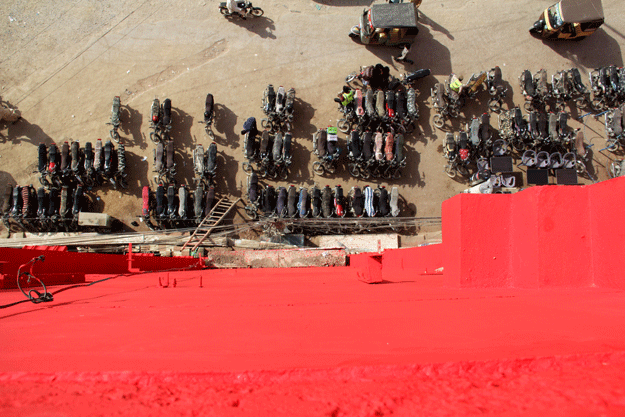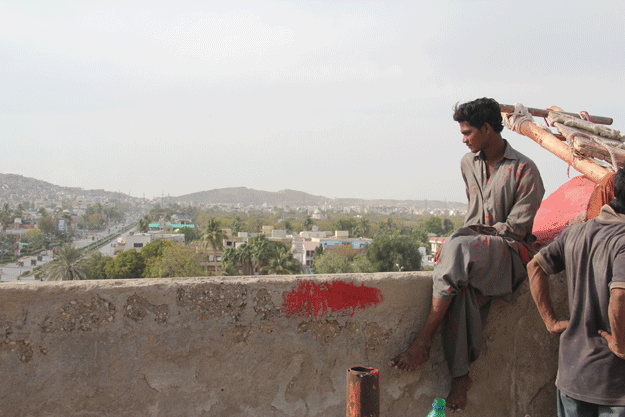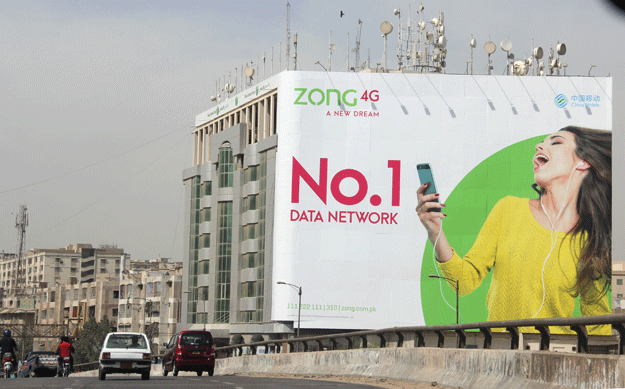
KARACHI: “We offer some sadqah [charity] before we start our work. Allah is up there and, down here, we have faith in Him,” said 21-year-old Imran, as he mounts a makeshift propeller to start painting the façade of a high-rise building in Karachi.
Imran is one of the many such graffitists who risk their lives every day as they paint advertisements across residential buildings, flyovers and underpasses - a new trend that emerged ever since the Supreme Court restricted large hoardings and billboards in the city in May last year.
 PHOTO: AYESHA MIR/EXPRESS
PHOTO: AYESHA MIR/EXPRESSLast year, the apex court had directed the additional attorney-general, Salman Talibuddin, and provincial advocate-general, Nisar Ahmed Durrani, to conduct meetings with all the civic agencies that grant permission for installing such outdoor advertisements to finalise the amendments to the proposed bylaws applicable beyond ‘public properties’ to achieve city-wide uniformity and ensure safety measures for citizens.
Artists immortalise LHC building in paint
An advocate of Public Interest Law Association of Pakistan, Summaiya Zaidi, said that the outdoor advertisement associations are still waiting for a hearing date from the court. However, for such commercial graffiti on high-rise buildings, she said that they are not illegal as there are no government regulations against them.
 PHOTO: AYESHA MIR/EXPRESS
PHOTO: AYESHA MIR/EXPRESSOn Monday, Imran was dabbing red paint outside the six-storey Sareena Apartments at Sakhi Hassan Chowrangi in North Nazimabad, perched on a rickety wooden plank which was dangling off a 100-metre-long and four-inch-wide rope. And he is not alone as three other of his colleagues are dangling off their own makeshift harnesses at different points of the same building. They will make Rs2,000 for the day’s work.
As soon as he finished painting one section, Imran blows a whistle and his co-worker, who is sitting on the rooftop loosens the rope to lower the wooden plank. On the rooftop, this rope is tied to a ladder which is placed diagonally along the wall and some concrete bricks are placed over it to give weight.
 PHOTO: AYESHA MIR/EXPRESS
PHOTO: AYESHA MIR/EXPRESS“This is a swing” is how Muhammad Saleem, who is monitoring the activity, describes the harness. The wood plank tied with a rope is so strong that it can lift a car, he boasted.
He dismisses the need for a helmet, safety harness or even belts as items that will create hassle. “All the graffitists get training of at least two years from our master before they start painting high-rise buildings,” he said. “We have become immune now and we are not afraid of heights.”
Saleem admitted renting machines would be more expensive than using wooden planks for the graffitists. Large multinational companies pay millions of rupees on advertising campaign yet there is no regard for the safety of these labourers.
Labour bylaws
Sindh Labour department’s joint director for District East, Gulfam Nabi Memon, told The Express Tribune that the Sindh Factory Act 2015’s chapter three on health and safety talks about safety precautions of the labourers.
 PHOTO: AYESHA MIR/EXPRESS
PHOTO: AYESHA MIR/EXPRESSSection 41 of this chapter states that, in every factory, all places of work where a worker may be liable to fall a distance exceeding three feet and six inches shall be provided with fencing or other suitable safeguards. However, the law mentions nothing about wearing helmet or a belt.
The journey of Karachi's art scene
To this, Memon responded that there is a new law - the ‘Sindh Occupational and Health’ law - approved by the chief minister and is supposed to be passed by Sindh Assembly. It talks about further precautionary measures for labourers in Sindh, he added.
According to Memon, the labour department is only functional in four of Karachi’s six districts. District East also covers Korangi and Malir districts and has only five members to inspect labour rights. In all of Sindh, he said that they have only 130 inspectors.
If their inspectors find any violations in labour rights during inspection, they give the contractors seven days. If the violation is not addressed, Memon said that they submit a challan in the labour court. However, the law does not permit any imprisonment in such cases and the contractor can only be fined for the offence.
Meanwhile, Pakistan Institute of Labour, Education and Research executive director Karamat Ali, said that Article 9 of the constitution talks about the right of life for every citizen and it is the responsibility of every contractor to ensure the safety of its workers.
















































COMMENTS
Comments are moderated and generally will be posted if they are on-topic and not abusive.
For more information, please see our Comments FAQ